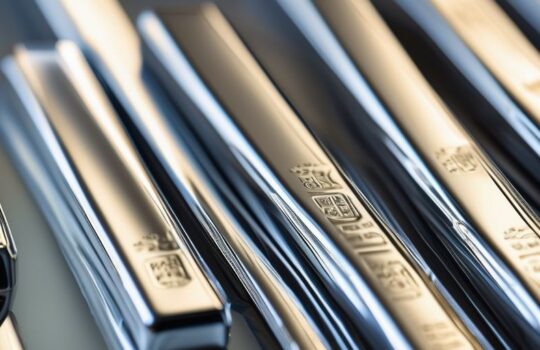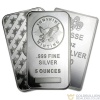Exploring the Different Types of Gold Bullion
Gold bullion is a popular investment option for individuals looking to diversify their portfolios or preserve wealth. In this section, we will delve into the history, sizes, weights, and uses of gold bullion bars, as well as explore the advantages and disadvantages of gold bullion coins.
Understanding the history and significance of gold bullion is essential in appreciating its value. For centuries, gold has been treasured by ancient civilizations as a store of value and a symbol of wealth. Its scarcity and durability have made it an ideal form of currency throughout history. Gold's role in shaping economies and monetary systems cannot be overstated.
When it comes to gold bullion bars, they come in various sizes and weights to cater to different investor preferences. Common sizes include 1 oz, 10 oz, and 1 kg bars. The weight of these bars can range from a few grams to several kilograms. The purity levels also vary, with most bars being at least 99.9% pure gold. These bars are primarily used for investment purposes due to their high gold content.
On the other hand, gold bullion coins offer unique advantages and disadvantages compared to bars. Coins like the American Gold Eagle or Canadian Gold Maple Leaf are highly liquid and easily bought or sold on the market. They also hold collectible value, which can potentially increase their worth beyond their intrinsic metal value. However, coins generally carry higher premiums compared to bars due to production costs.
By exploring the different types of gold bullion – from bars to coins – investors can make informed decisions based on their investment goals and preferences. In the following sections, we will delve deeper into each aspect of gold bullion to provide you with a comprehensive understanding of this precious metal's various forms.
The History and Significance of Gold Bullion
Origins and Cultural Significance
Gold has held a special place in human history for thousands of years. Ancient civilizations recognized its intrinsic value and used it as a store of wealth. From the Egyptians to the Greeks, gold was treasured for its rarity, beauty, and durability.
In ancient Egypt, gold was associated with the gods and pharaohs. It symbolized power, wealth, and immortality. The Egyptians used gold to create intricate jewellery, burial masks, and other precious artifacts that were buried with their rulers.
The Greeks also revered gold for its cultural significance. They believed that gold was a divine metal bestowed upon them by the gods. Gold coins were minted as early as 600 BC in Lydia (modern-day Turkey) and quickly spread throughout the Mediterranean region.
Evolution of Gold Bullion
Over time, gold evolved from being traded in its natural form as dust or nuggets to more standardized forms such as bars and coins. This transition allowed for easier storage, transportation, and trade.
The concept of standardized gold bars emerged during the Roman Empire when they introduced a system called "aes rude" or rough bronze. This system eventually led to the development of solid metal bars that were stamped with official marks to guarantee their weight and purity.
However, it was during the Middle Ages that gold bullion truly gained prominence. European countries started issuing gold coins as a form of currency backed by their respective governments. These coins became widely accepted means of exchange in international trade.
With advancements in technology during the Industrial Revolution, refining techniques improved significantly. This led to higher levels of purity in gold bullion production and increased confidence among investors.
Today, gold bullion continues to play an important role in global economies and investment portfolios. Its historical significance as a store of value remains intact while its practical uses have expanded into various industries such as electronics, dentistry, and aerospace.
Understanding the history and significance of gold bullion provides a foundation for appreciating its enduring value. In the next section, we will explore the different sizes, weights, and uses of gold bullion bars.
Gold Bullion Bars: Sizes, Weights, and Uses
Different Sizes and Weights Available
Gold bullion bars come in a variety of sizes and weights to suit the needs and preferences of different investors. The most common sizes range from small fractional bars to larger kilogram bars.
For those looking for smaller investments or more flexibility, fractional gold bullion bars are available in sizes such as 1 gram, 2.5 grams, 5 grams, and 10 grams. These smaller bars offer affordability and ease of liquidation.
The most popular size among investors is the 1 ounce (oz) gold bar. It strikes a balance between affordability and value, making it highly sought after. Other common sizes include 10 oz and 1 kilogram (kg) bars, which are often preferred by institutional investors due to their higher gold content.
When it comes to weights, gold bullion bars can vary significantly. Some manufacturers produce bars weighing as little as a few grams, while others create massive bars weighing several kilograms. The weight of a bar affects its value, with larger bars generally commanding higher prices due to their increased gold content.
In addition to size and weight variations, purity levels also impact the value of gold bullion bars. Most standard gold bars have a purity level of at least 99.9%, meaning they contain only a minimal amount of impurities. However, some specialised bars may have even higher purity levels.
Practical Uses of Gold Bullion Bars
Gold bullion bars serve various practical purposes for both individual investors and industries alike. One primary use is as an investment asset for portfolio diversification. Gold has historically acted as a hedge against inflation and economic uncertainties, making it an attractive option for risk-averse investors.
Furthermore, gold bullion bars find applications in industrial sectors such as electronics and technology due to their excellent conductivity properties. They are used in the production of electronic components, connectors, and even spacecraft components. The unique properties of gold make it an essential material in these industries.
Gold bullion bars are also valued by collectors for their aesthetic appeal and historical significance. Some bars feature intricate designs or engravings that add to their allure. Collectors often seek out limited edition or rare bars, which can appreciate in value over time due to their scarcity and desirability.
Advantages and Disadvantages of Gold Bullion Coins
Benefits of Gold Bullion Coins
Gold bullion coins offer several advantages that make them a popular choice among investors and collectors alike.
One significant benefit is the high liquidity and ease of buying and selling gold bullion coins. These coins are widely recognized and accepted in the global market, making them easy to trade for cash or other assets when needed. The standardized weight, purity, and design of gold bullion coins ensure their authenticity, which further enhances their liquidity.
Another advantage of gold bullion coins is their potential for collectible value and numismatic premiums. Some coins feature unique designs, limited editions, or historical significance that can increase their worth beyond their intrinsic metal value. Collectors often seek out these special coins, creating an additional market demand that can drive up prices over time.
Gold bullion coins also provide investors with the opportunity to own fractional amounts of gold. Unlike larger bars, which may require a significant investment, coins allow individuals to start small and gradually build their holdings over time.
Drawbacks of Gold Bullion Coins
Despite their advantages, gold bullion coins do have some drawbacks that investors should consider.
One drawback is that gold bullion coins generally carry higher premiums compared to gold bars. The production costs associated with minting these coins contribute to the increased price tag. Therefore, investors pay a premium not only for the intrinsic value of the gold but also for the craftsmanship and collectability aspects.
Another concern when it comes to gold bullion coins is the potential for counterfeit coins in the market. Counterfeiters have become increasingly sophisticated in replicating coin designs and packaging, making it challenging for unsuspecting buyers to detect fakes. To mitigate this risk, it is crucial to purchase from reputable dealers who provide authentication guarantees.
Popular Gold Bullion Coins from Around the World
American Gold Eagle
The American Gold Eagle is one of the most well-known and widely recognized gold bullion coins in the world. First introduced in 1986 by the United States Mint, it quickly gained popularity among investors and collectors alike.
The design of the American Gold Eagle features a stunning depiction of Lady Liberty on the obverse, inspired by Augustus Saint-Gaudens' iconic Double Eagle design. The reverse showcases a family of eagles, symbolizing American patriotism and strength. These intricate designs add to the coin's aesthetic appeal and historical significance.
American Gold Eagles are minted in four different denominations: 1 oz, 1/2 oz, 1/4 oz, and 1/10 oz. Each coin contains its respective weight in pure gold and is backed by the United States government for weight and purity.
Due to their high quality and trusted reputation, American Gold Eagles are highly sought after by both investors and collectors. Their liquidity is unparalleled, making them easy to buy or sell in the global market. Additionally, their recognition as legal tender in the United States adds an extra layer of authenticity.
Canadian Gold Maple Leaf
The Canadian Gold Maple Leaf is another popular choice among gold bullion enthusiasts worldwide. Produced by the Royal Canadian Mint since 1979, these coins are renowned for their exceptional purity levels and exquisite craftsmanship.
One distinctive feature of the Canadian Gold Maple Leaf is its high purity level of 99.99%, making it one of the purest gold bullion coins available. This level of purity ensures that each coin contains virtually no impurities or alloy metals, enhancing its value as an investment asset.
The design of the Canadian Gold Maple Leaf showcases an intricately detailed maple leaf on the reverse side, Canada's national symbol. The obverse features Queen Elizabeth II's effigy along with its denomination and year of issue.
The Royal Canadian Mint has earned a reputation for producing high-quality coins with advanced security features to prevent counterfeiting. This commitment to quality has made Canadian Gold Maple Leafs highly regarded among investors who value authenticity and peace of mind.
Enhancing Your Knowledge of Gold Bullion
Gaining a deeper understanding of gold bullion is essential for investors, collectors, and anyone interested in precious metals. By delving into its historical context, practical uses, and popular coins, you can enhance your knowledge and make informed decisions.
Exploring the historical context of gold bullion allows you to appreciate its enduring value. Understanding how ancient civilizations used gold as a store of wealth and its role in shaping economies provides valuable insights into its significance today.
Considering the practical uses and advantages of different forms of gold bullion helps you determine which option aligns with your investment goals. Whether it's investing in bars for portfolio diversification or exploring the potential collectible value of coins, each form has its own benefits that cater to different preferences.
Exploring popular gold bullion coins can provide valuable insights into potential investment options. Coins like the American Gold Eagle and Canadian Gold Maple Leaf have established reputations among investors and collectors due to their high quality, recognized designs, and liquidity.
By enhancing your knowledge of gold bullion, you empower yourself to make informed decisions based on historical significance, practicality, and market trends. Whether you are an investor seeking to diversify your portfolio or a collector looking for unique pieces, understanding the various aspects of gold bullion will guide you towards making sound choices in this fascinating world of precious metals.











